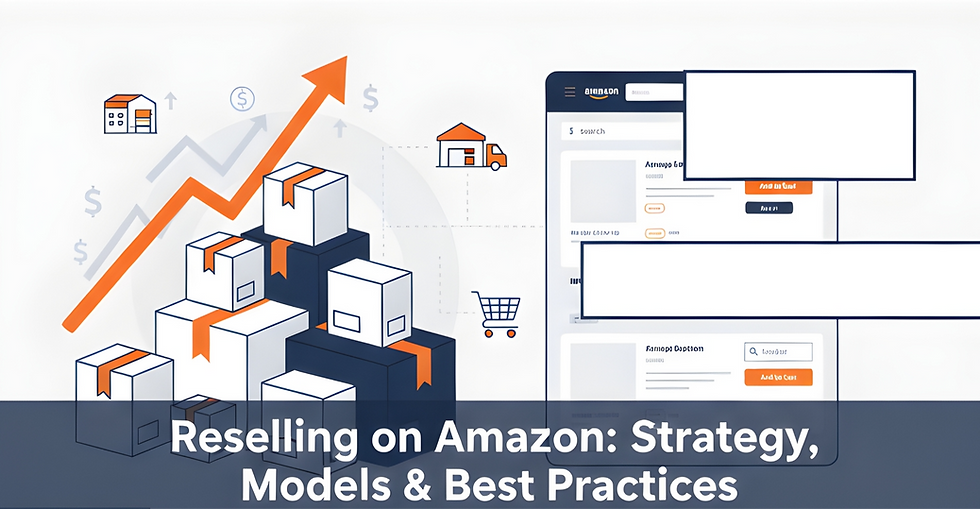How to Sell Video Games Online: A Smart Seller’s Guide
- walbayzonllp
- 3 days ago
- 3 min read
By WalBayZon — Turning Your Game Collection into Revenue
Introduction
Do you have a stack of video games, consoles, or limited editions gathering dust? Whether you’re clearing your collection or building a resale business, video games and gaming gear can be profitable items to sell online.
Amazon’s official guide on “How to Sell Video Games Online” provides a concise set of steps for game sellers. In this post, WalBayZon expands that into a structured, actionable blueprint — so you can start reselling with confidence and scalability.
1. Inventory Audit & Categorization
Before listing anything, take stock of what you own. Group items into categories such as:
Retro / Classic Consoles & Games
Current-Gen Games & Consoles
Limited Edition / Collectibles
Gaming Accessories (controllers, cables, skins, VR gear)
Assess each item’s condition, box/manual presence, completeness, and working status. Games with original packaging, manuals, and minimal wear will often command higher prices.
Pro Tip: Clean and inspect every game and console thoroughly — a well-presented item reflects higher perceived value.
2. Choosing Sales Channels
What marketplaces or channels can you use to sell?
2.1 Established Online Platforms
Big e-commerce sites (Amazon, eBay, local marketplaces) help you reach a large audience.
2.2 Gaming-Specific Retailers / Niche Platforms
Sites that specialize in gaming gear or retro games often attract enthusiasts willing to pay premium.
2.3 Local Channels
Classifieds, gaming meetups, local Facebook groups — avoid shipping fees for bulky items.
2.4 Specialty / Collector Platforms
For rare or high-value titles, platforms focused on collectors often yield better returns.
WalBayZon advice: Use multiple channels in parallel, but be careful with inventory synchronization to avoid overselling.
3. Pricing & Listing Strategy
3.1 Price Research & Comparisons
Check what similar items are selling for across platforms. Analyze completed listings, not just current listings.
3.2 Account for Fees & Shipping
Don’t forget platform referral fees, shipping cost, possible import duties (if cross-border). Ensure margin stays healthy after all costs.
3.3 Create Compelling Listings
Take high-quality images from multiple angles
Show the condition clearly (scratches, dents)
List all included accessories (cables, manuals, original box)
Use relevant keywords (console name, edition, year)
Be transparent about condition to build trust
3.4 Packaging & Shipping
Use sturdy packaging with bubble wrap, anti-static bags (for electronics), and tracking. Good shipping experience reduces negative feedback.
WalBayZon note: For consoles or heavy items, consider offering local pickup to save on shipping or increase margin.
4. Condition Grading & Transparency
Condition matters greatly in gamer communities. Buyers expect honesty.
Use standard condition terms (New, Like New, Very Good, Acceptable)
Provide condition notes (e.g. “minor scratch on bottom edge”, “tested working”)
If parts are missing (manuals, cables), disclose it
If you refurbish or repair, indicate that — and test before shipping
Incorrectly stating condition can lead to returns, negative reviews, or account issues.
5. Sourcing Additional Inventory
To scale, you’ll need more than your own collection.
Check thrift stores, garage sales, pawnshops, local classifieds
Monitor clearance sales, auctions, overstock liquidation
Network with local game shops willing to sell used stock
Buy bundles (e.g. console + games) and resell into individual components
WalBayZon tip: Always test items before accepting or buying; broken consoles can be very costly to repair or unsellable.
6. Fulfillment & Order Management
Fulfillment Options
Self-managed (FBM / merchant) — you store, pack, and ship.
Fulfillment by Amazon (FBA) — Amazon handles storage, picking, shipping, and returns (if allowed for video game category)
Hybrid — use FBA for smaller, high-demand items; self-fulfill bulky or low-margin ones
Inventory Control & Synchronization
Track stock across channels. If you sell on Amazon + your own site, use inventory sync tools to prevent negative stock or cancellation.
7. Growth & Scaling Strategies
Focus on high-demand SKUs first
Cross-sell accessories with games
Bundle slowly (e.g. console + game) to increase perceived value
Offer limited editions or collectibles to niche buyers
Use data analytics to see which titles or generations perform best
Experiment with pricing, promotions, or sponsored ads
Collectors often pay premium — so branding and presentation can differentiate you from casual sellers.
8. Challenges & Risks to Be Aware Of
High return risk — used electronics may have failures.
Counterfeit / authenticity issues — buyers care deeply; be ready to prove authenticity.
Platform fees / margin compression — thin margins on some titles.
Inventory aging / obsolescence — older consoles may lose value if too niche.
Shipping damage — electronics and games are delicate.
Mitigate risks by careful packaging, clear returns policy, testing, and hub of reputation.




Comments